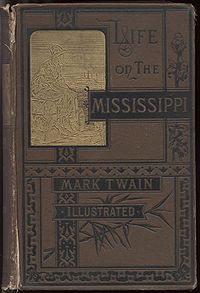Life on the Mississippi
 Cover of the original U.S. edition, 1883. | |
| Author | Mark Twain |
|---|---|
| Country | United States/England |
| Language | English |
| Genre | biography |
| Publisher | James R. Osgood & Co., Boston (U.S. edition) Chatto & Windus, London (English edition) |
Publication date | 1883 |
| Media type | |
| Pages | 624 [1] |
| Preceded by | The Prince and the Pauper |
| Followed by | Adventures of Huckleberry Finn |
Life on the Mississippi (1883) is a memoir by Mark Twain of his days as a steamboat pilot on the Mississippi River before the American Civil War, and also a travel book, recounting his trip along the Mississippi River from St. Louis to New Orleans many years after the War.
The book begins with a brief history of the river as reported by Europeans and Americans, beginning with the Spanish explorer Hernando de Soto in 1542.[2] It continues with anecdotes of Twain's training as a steamboat pilot, as the 'cub' (apprentice) of an experienced pilot, Horace E. Bixby. He describes, with great affection, the science of navigating the ever-changing Mississippi River in a section that was first published in 1876, entitled "Old Times on the Mississippi". Although Twain was actually 21 when he began his training, he uses artistic license to make himself seem somewhat younger, referring to himself as a "fledgling" and a "boy" who "ran away from home" to seek his fortune on the river, and playing up his own callowness and naïveté.
In the second half, Twain narrates his trip many years later on a steamboat from St. Louis to New Orleans. He describes the competition from railroads, and the new, large cities, and adds his observations on greed, gullibility, tragedy, and bad architecture. He also tells some stories that are most likely tall tales.
Simultaneously published in 1883 in the United States and Great Britain, the book is the first submitted to a publisher as a typewritten manuscript.[3]
Adaptations
In 1980 the book was adapted as a TV movie for American public television, with David Knell performing as Sam Clemens (Mark Twain's real name), and Robert Lansing as Horace Bixby, the steamboat pilot who mentored him. The film used many tall tales from the book, woven into a fictional narrative.
In 2010, Life on the Mississippi was adapted as a stage musical, with book and lyrics by Douglas M. Parker and music by Denver Casado. It was produced that year in Kansas City, Missouri and Door County, Wisconsin.
See also
- George Washington Cable
- Firefighter
- Lagniappe
- Joseph Alexander Mabry, Jr.
- Mark Twain Birthplace State Historic Site
- Mark Twain Boyhood Home & Museum
- Mud clerk
- Paddle steamer
- Riverboat
- Steamboat
- Steamboats of the Mississippi
References
- ^ Facsimile of the original 1st edition.
- ^ Twain, Mark; Clemens, Samuel L. (1883/2000). Life on the Mississippi. Mineola, NY: Dover. p. 3. ISBN 978-0-486-41426-3.
{{cite book}}: Check date values in:|year=(help)and
Facsimile copy of the First edition, page 26"[...] De Soto, the first white man who ever saw the Mississippi River, saw it in 1542 [...]" - ^ "The First Typewriter". Rehr, Darryl. Retrieved 2009-02-16.
External links
- Life on the Mississippi at Project Gutenberg
- Life on the Mississippi from the University of North Carolina at Chapel Hill
- IMDb entry for PBS movie
- Images of First London Edition
- Images of First U.S. Edition
